First, there was just one acronym: SEO. Today, it’s like you’re walking past a daily-expanding buffet showcase of acronyms for optimization as a fundamental part of online marketing. And when you haven’t even fully digested SEO, every other article is already putting AEO and GEO onto your plate, all while reassuring you, “Trust me, it’s worth a taste!”
In fact, it’s generally recommended to invest in the following shares of optimization strategies:
- 60% → for SEO (Search Engine Optimization)
- 25% → for AEO (Answer Engine Optimization)
- 15% → for GEO (Generative Engine Optimization)
But don’t hurry to grab this recipe and leave. Because some are already crying out loud: “AEO is the new SEO!” At the same time, others strongly advise relying on GEO as a more comprehensive approach in the search kitchen, where artificial intelligence is slowly but steadily growing into a master chef.
So, what’s the difference between SEO, AEO, vs. GEO? Should you pick and prioritize only one or perhaps absorb them all in equal (or not so equal) parts?
Let’s have a closer look at each before “byting” into them.
Why This Matters Right Now

Search is no longer a channel. People continue to utilize the traditional search engines, but they are also demanding direct answers on the results page and are also relying on AI systems that synthesise information. When you consider this to be SEO, you are closing off visibility. The contemporary model incorporates three levels: SEO to rank conventionally, AEO to direct answers, and GEO to be included within the AI-generated responses.
What Changes in 2025

- The zero-click behaviour increases, and therefore, your content should respond fast on the result page.
- This change also brings out the issue of AI-generated content in SEO, as poorly optimised AI text may increase visibility, and high-quality content can increase visibility.
- Entity understanding is more significant, and your brand and topics must be clean with steady names and accurate descriptions.
SEO, AEO, GEO: Choosing the Right Optimization Approach

First, there was just one acronym: SEO. Today, it’s like you’re walking past a daily-expanding buffet showcase of acronyms for optimization as a fundamental part of online marketing. And when you haven’t even fully digested SEO, every other article is already putting AEO and GEO onto your plate, all while reassuring you, “Trust me, it’s worth a taste!”
In fact, it’s generally recommended to invest in the following shares of optimization strategies:
- 60% → for SEO (Search Engine Optimization)
- 25% → for AEO (Answer Engine Optimization)
- 15% → for GEO (Generative Engine Optimization)
But don’t hurry to grab this recipe and leave. Because some are already crying out loud: “AEO is the new SEO!” At the same time, others strongly advise relying on GEO as a more comprehensive approach in the search kitchen, where artificial intelligence is slowly but steadily growing into a master chef.
So, what’s the difference between SEO, AEO, vs. GEO? Should you pick and prioritize only one or perhaps absorb them all in equal (or not so equal) parts?
Let’s have a closer look at each before “byting” into them.
Everything You Should Know About SEO
What Is Search Engine Optimization?
As conventional as it goes, SEO makes a website or page found and ranked on traditional search engines, such as Google or Bing.
So, businesses do the following for an effective SEO strategy to land a higher ranking on the SERP (search engine results page):
- Off-page SEO → Backlinks, content syndication, PR promotion in marketing, etc.
- On-page SEO → Keywords, headings, titles, tags, or other elements on web pages
- Local SEO → Google Business Profile listings, online reviews, keywords with location modifiers like states, cities/towns, neighborhoods, streets, etc.
- Tech SEO → Mobile-first pages, page loading speeds, well-structured URLs, etc.
When Is It Better to Prioritize SEO in Your Optimization Strategy?
- When you want to rank #1, not #201, in SERPs
- When you aim at driving organic traffic to your website
- When the search intent is commercial or transactional
- When you’re targeting customers locally
For example:
Let’s take the event industry and the keyword with the geographic modifier: “team-building activities in Hartford, CT.” You may notice Outback ranking twice in the top ten of the SERP, all thanks to optimized meta titles and descriptions for the local search.
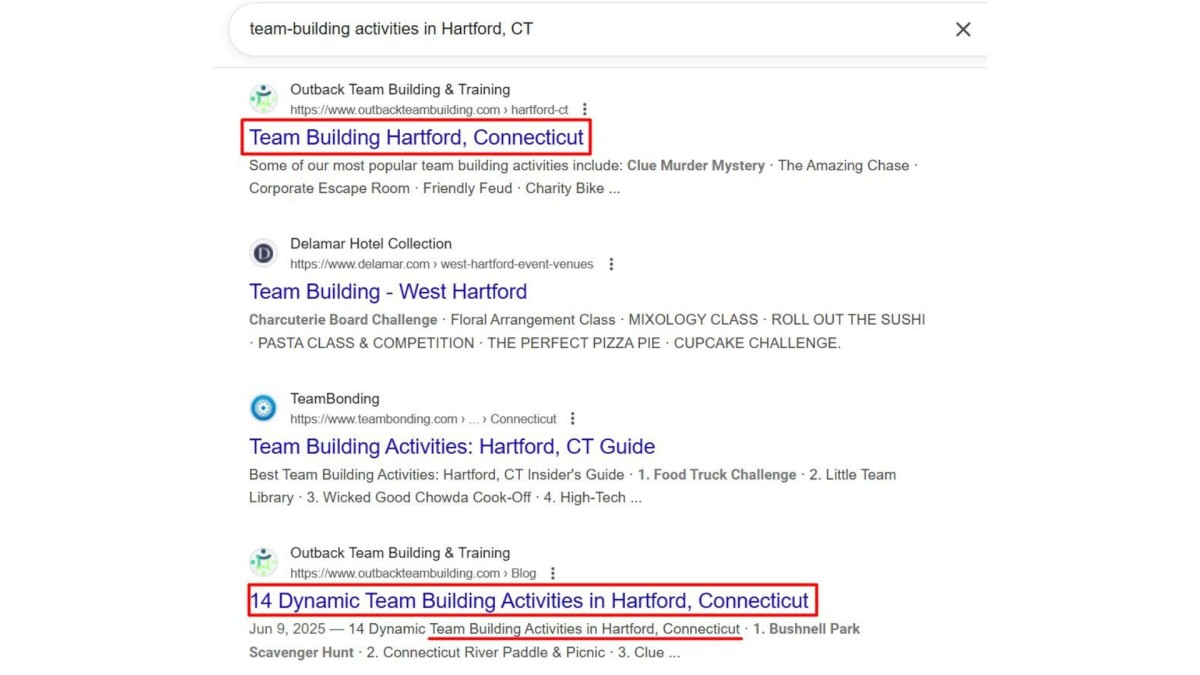
Everything You Should Know About AEO
What Is Answer Engine Optimization?
Skipping the small talk and lengthy intros, AEO is focused on giving people exactly the information they ask for in its shortest form.
It involves optimization for:
- Question-and-answer (Q&A) formats
- Featured or rich snippets
- Frequently asked questions (FAQs)
- Google’s “People Also Ask” (PAA) section
- Voice searches
As people often seek direct answers from AI voice assistants (Alexa or Siri) or chatbots (Gemini or Copilot), these technologies are reshaping the future of AI marketing and AEO.
When Is It Better to Prioritize AEO in Your Optimization Strategy?
- When you need to give a one-breath answer to your audience
- When you compete for featured snippets
- When you target customers shifting to conversational AI and AI-powered voice search (location-based or not)
For example:
Suppose you need a quick answer in the realm of property financing and type, “What is a mortgage in real estate?” As a result, you get the following two-sentence response AEO-optimized for Google’s featured snippet and more similar Q&As in the PAA section.

Everything You Should Know About GEO
What is Generative Engine Optimization?
Unlike traditional SEO, GEO aims at making large language models (LLMs powered by AI) better understand and recommend your brand or content in AI-generated texts.
This relates to:
- ChatGPT
- Google’s AI Overview
- Claude
- Gemini
- Perplexity
- Or other LLMs
In fact, while Google is still winning the SEO game (with 14B searches daily), ChatGPT receives around 37.5M searches, opening a vast field for GEO. Yet, so far, fewer than 1% of enterprises and SMBs allocate their marketing budgets to generative engine optimization.
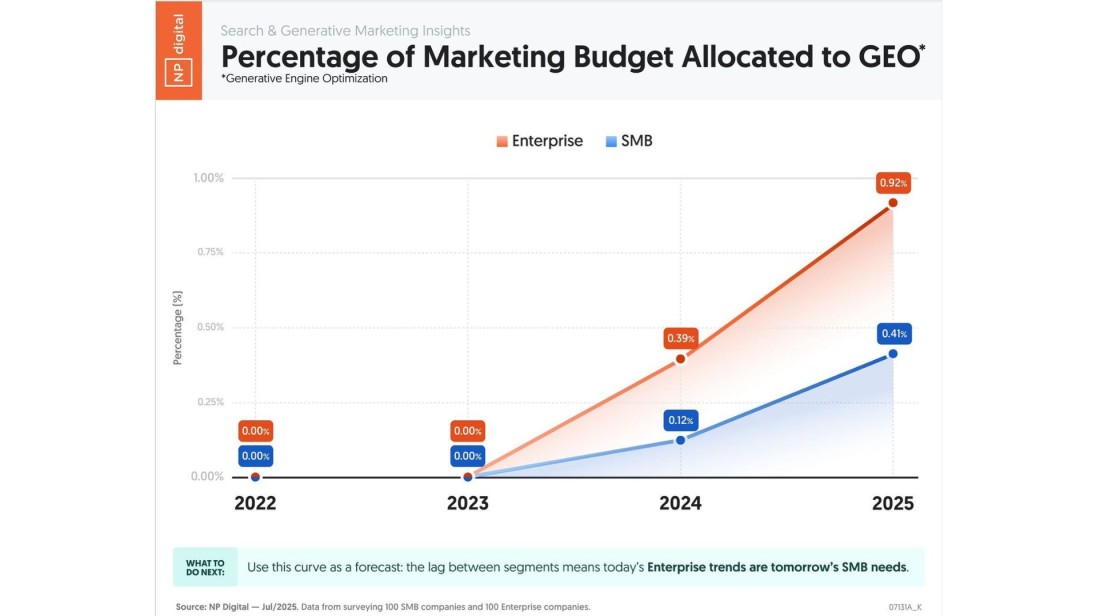
When Is It Better to Prioritize GEO in Your Optimization Strategy?
- When you already have solid SEO bedrock (Remember: GEO isn’t a replacement strategy for SEO, it’s rather a layer on top of it.)
- When you want to boost brand awareness with mentions, not necessarily with clicks-through (AI often generates answers without links).
- When you publish “evergreen” content (universal tips, how-to guides, listicles)
- When your audiences use generative AI (aka GenAI) for content discovery (including local search)
For example:
Look at this answer generated by ChatGPT when asked about specific restaurant types (Italian) in NYC. It provides links to GEO-optimized lists like “The 27 Best Italian Restaurants in New York City” by The Infatuation.
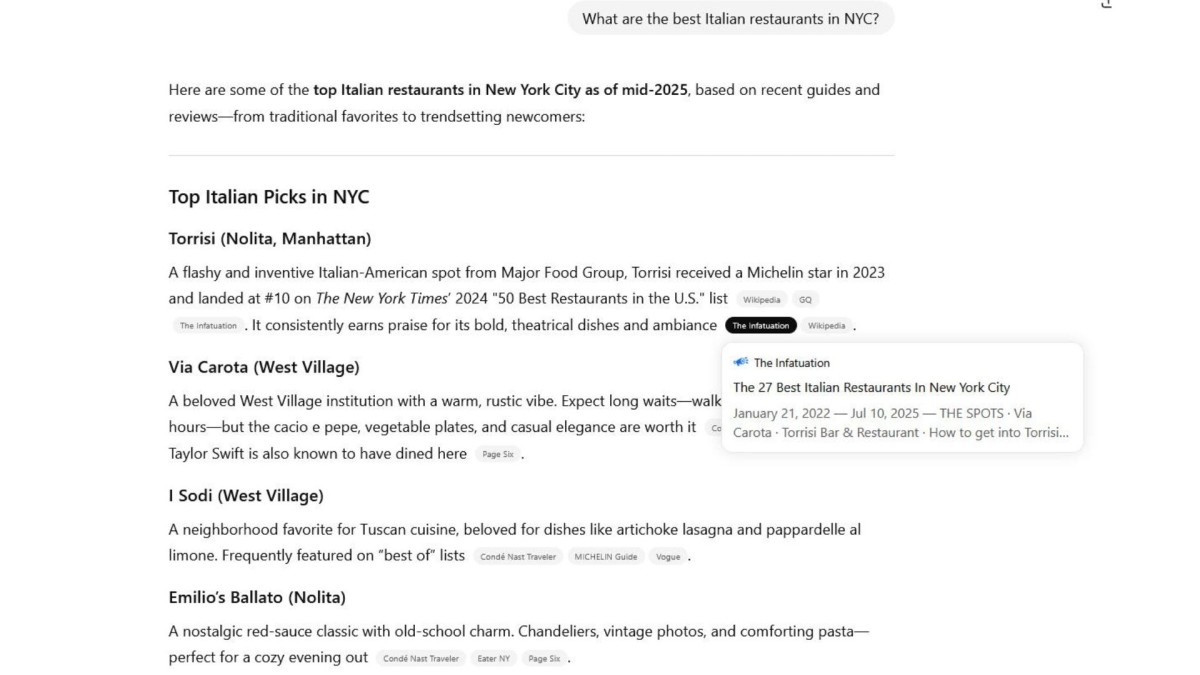
How to Use Each—Top Strategies for SEO, AEO, and GEO
Now that you know the “When,” it’s time to learn the “How” of optimizing for SEO vs. AEO vs. GEO.
The Best Practices for Search Engine Optimization
Secure a Front Row Seat in a Branded Search
Would you like to pull quality traffic to your website with the power of your brand name? (Who wouldn’t!)
You can easily do that with branded keywords for SEO. These are search phrases related to your company’s name or products/services.
Here, you should also optimize the right web pages with not merely your brand name keyword but also compounds like these:
- [Company] product or [Company] service (for your product/service pages)
- [Company] customer reviews (for your “Testimonials” page)
- [Company] jobs (for your “Careers” page)
For example:
Let’s review the case of Nike, a well-known name in sports footwear and apparel. When googling, “Nike leave a review,” the top-ranked organic result is the company’s page optimized with branded keywords and compounds like “Nike reviews” or “share my Nike look.”
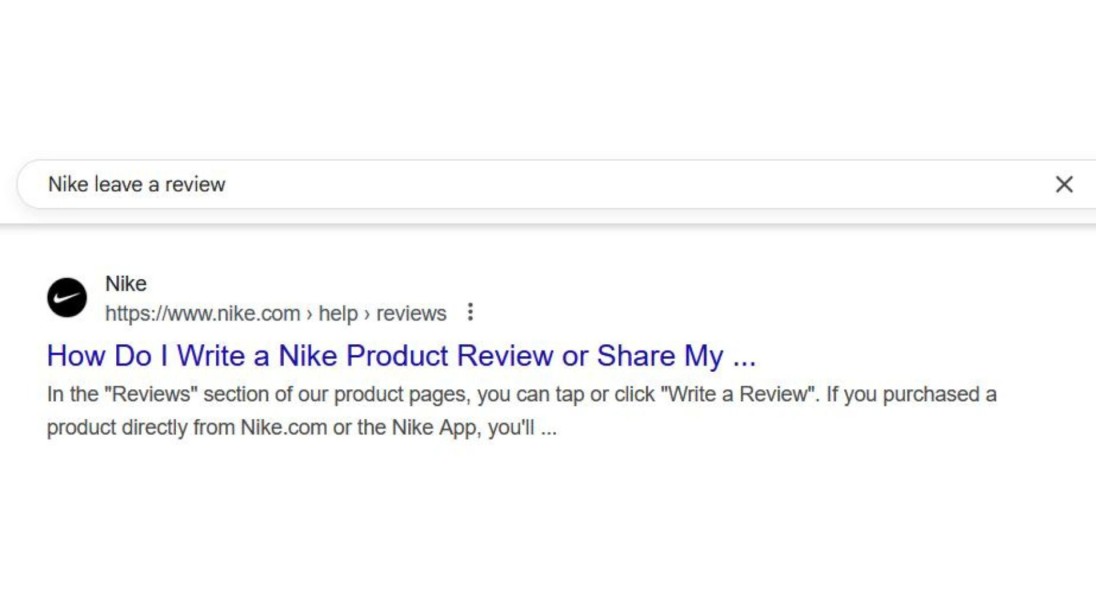
It’s actually a perfect blend of a successful SEO strategy, branding, and review management on the website.
Tap Into Social Media SEO
Search engine optimization on social media is blossoming these days. Can you guess the reason? Yes, people tend to search more frequently across social platforms. And some even outperform Google in this context, in fact, 40% of young people don’t go to Google Maps or Search when they need to find a place for lunch, they go to TikTok or Instagram.
That’s why many brands are hurrying to pack their social media profiles and posts with links and keywords.
Links and Keywords in Profiles
For example:
See how Lois Reed, a graphic designer, optimized her profile with the website link and keywords (“website designer,” “graphic design,” and others) in the “About” section on LinkedIn.
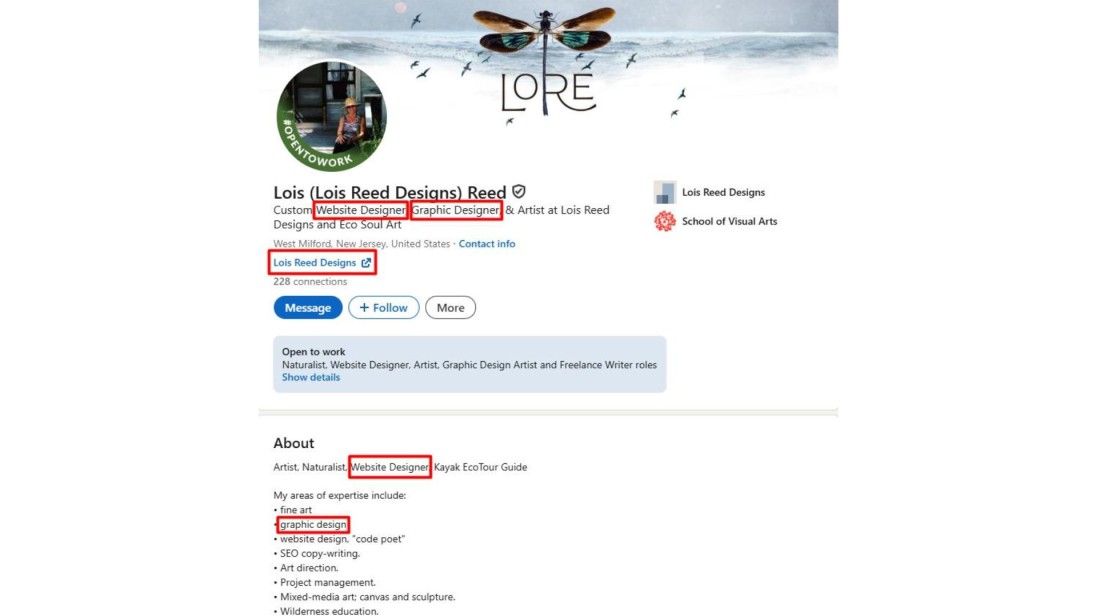
Links and Keywords in Posts
For example:
Knowing that people go to Pinterest for ideas and inspiration when planning a purchase (at least nine in ten do!), you’d definitely choose this social platform for search engine optimization.
That’s what ISS Decor did for holiday SEO with keywords like “budget-friendly Christmas DIY decorations” and “cheap Christmas decorations DIY.”

The Best Practices for Answer Engine Optimization
Optimize Your Pages with FAQs and Target Question Keywords
If you’ve ever typed a random question into Google (something like, “Can I eat watermelon seeds?”) and got a super-precise answer (if you wondered, too: yes, you can, both the black and white seeds, as a matter of fact), you’ve already experienced AEO’s magic in action.
That’s why FAQs on your blog or product/service pages are pure gold for answer engine optimization. Start them with question indicators to form long-tail keywords (AEO and SEO go hand in hand here):
- What
- How much
- How often
- When
- Why
- Can
- Is
- Should
For example:
Here’s how the music company embedded an FAQ section for AEO with questions like, “Can I upload my own music to Spotify?”
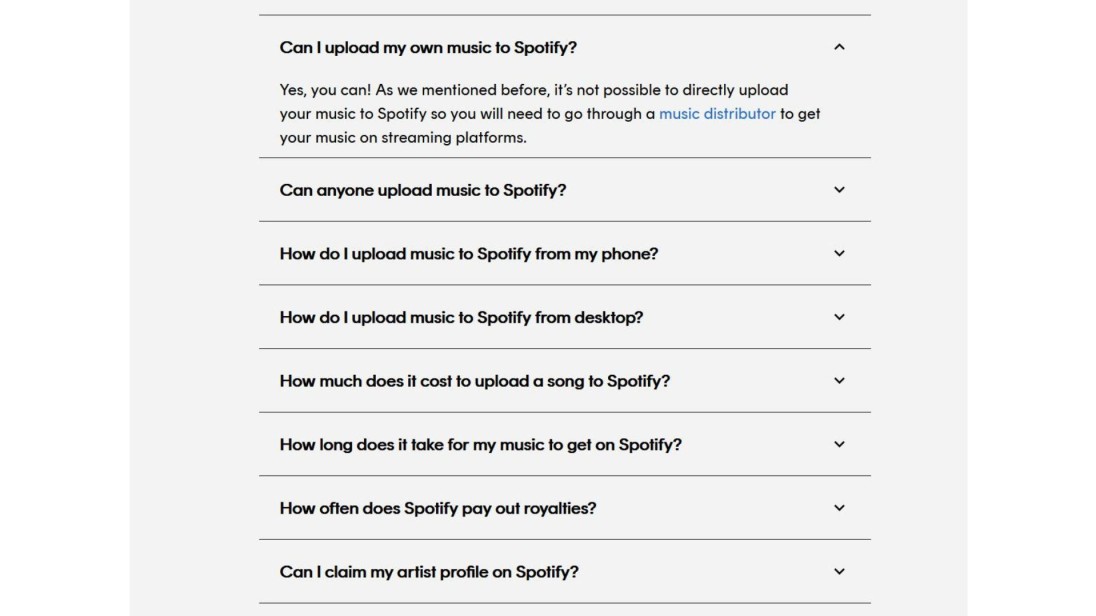
Sure, you could simply suppose or hypothesize what your potential customers are interested in. But why not turn to automatic solutions like a keyword research tool? It will help you scrape the most popular (and relevant!) question phrases for a more effective AEO strategy.
Stick to Optimal AEO Length
No, you don’t need to craft an epic novel every time you type (or AI-generate) a response for AEO. The more laconic and accurate, the better.
However, you should always keep in mind the following AEO-friendly lengths:
- For featured snippets → under 40–60 words
- For voice search → under 8–10 seconds
Particularly, it’s critical for the Yes/No format or numerical responses to “nourish” them with the “juiciest” part first or front-load them.
For example:
Let’s pun-tastically drive into the automotive niche and ask, “How much does it cost to wrap a Cybertruck?” You get short and sweet replies from Google in both the featured and the PAA snippet.
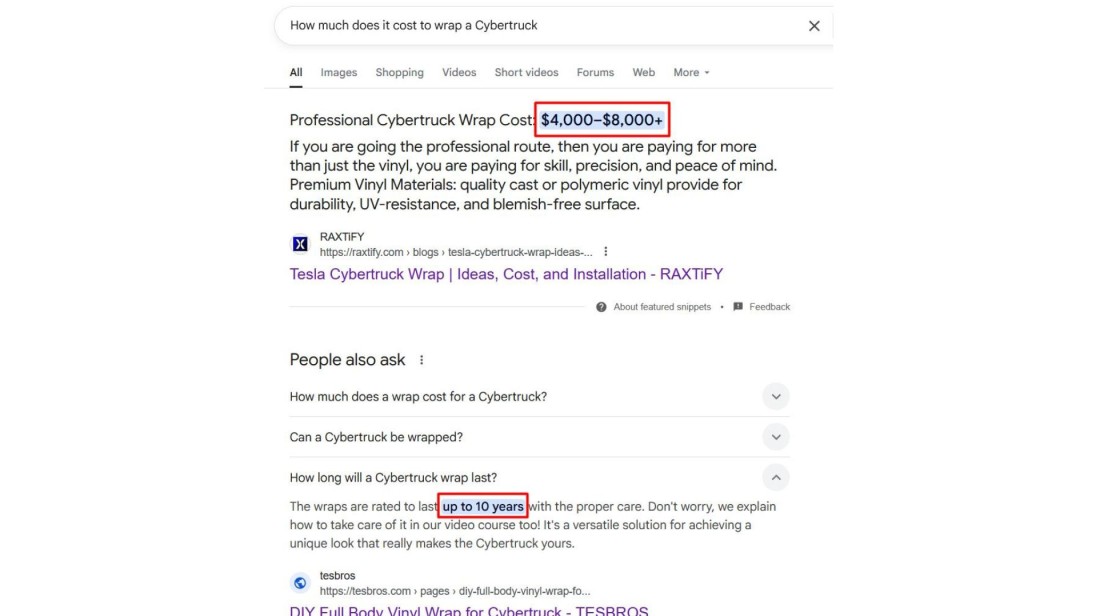
And both brands, TESBROS and RAXTiFY, have satisfactory FAQ lengths for AEO.
The Best Practices for Generative Engine Optimization
Write and Structure Your Blog Content for Both Human and AI Readability
Even if you opt for AI tools to create blog articles on autopilot, humanize them with a personalized approach: personal stories, examples, or even pinches of humor.
Also, an adequate structure is essential for generative engines and people consuming your content:
- Headings and subheadings
- Shorter paragraphs
- Lists and bullet points
- FAQ schema markup
- Helpful multimedia (images, videos, audio clips)
For example:
Let’s peek into GEO among B2B agencies. Get a glimpse of this article by Viva that targets companies looking to hire virtual assistants.
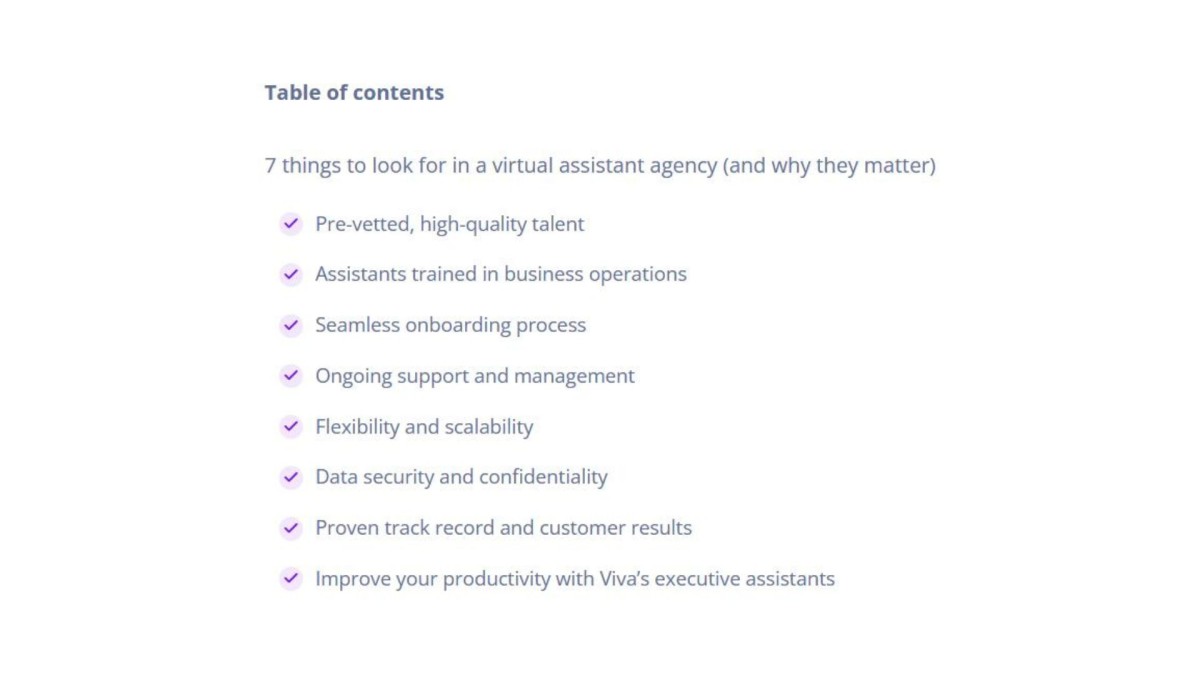
The Table of Contents improves the article’s scannability so that LLMs can extract precise points when someone asks or searches, “What should I look for in a virtual assistant agency?” Plus, there are additional lists under each subheading for better content structuring in the GEO strategy. The paragraphs are short, well-readable, and skimmable.
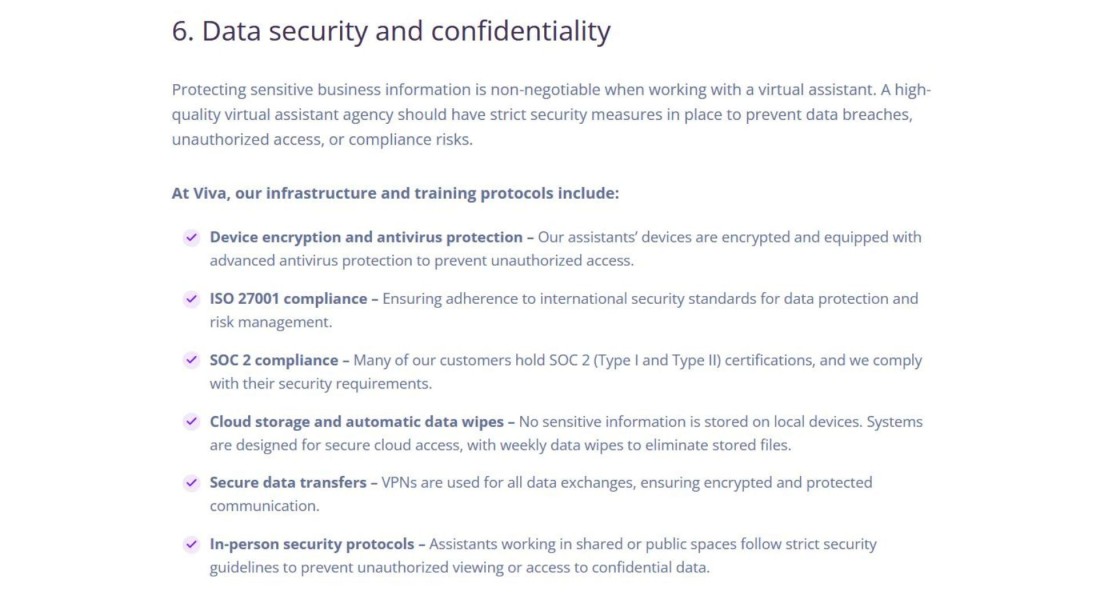
(Note: many people prefer skimming, not reading, these days.)
Choose NLP keywords
Having selected the right question keywords for AEO, you likewise need the proper NLP keywords for a great GEO strategy. It’s no secret sauce just bread and butter for generative search engines as they are “fed” with NLP (natural language processing) algorithms to be able to comprehend and interpret human speech (written or oral).
So, pick NLP terms to optimize your content for GEO while stepping into the future of SEO:
- Conversational (majorly long-tail) keywords: They literally coincide with the way people speak, using multi-word rather than one-word phrases.
- Semantic keywords: Synonymic rows or keyword variations that describe the search intent and context.
For example:
Explore how the fashion and apparel brand GEO-optimized the page for blank wholesale T-shirts. The keywords are semantically rich for GenAI engines to understand and summarize them into answers: “blank T-shirts at wholesale prices” or “wholesale T-shirts for every occasion.”

Then, there are long-tail keywords in FAQs: “How long does it take to receive an order for wholesale T-shirts?”
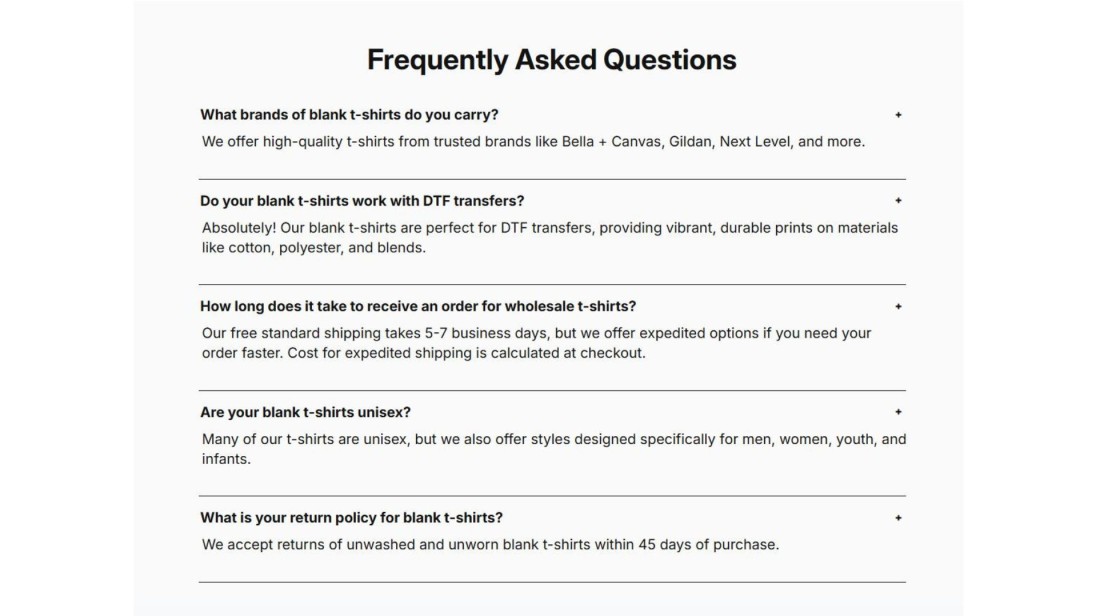
SEO vs. AEO vs. GEO What’s Your Choice?
Just like you fill a balanced plate with different foods for healthy eating, it makes sense to incorporate all three ingredients into your strategy:
- Search engine optimization (SEO)
- Answer engine optimization (AEO)
- Generative engine optimization (GEO)
But the key takeaway is to decide on the right proportions based on your business goals and your audience’s needs. Only afterward, follow the above-mentioned tips for SEO, AEO, or GEO. And happy optimizing!
P.S.: Don’t forget to subscribe to Zoviz for more actionable insights like these.








